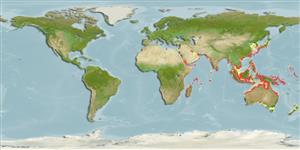Common names from other countries
Environment: milieu / climate zone / depth range / distribution range
Ecología
marino; anfidromo (Ref. 51243); rango de profundidad 5 - 100 m (Ref. 52753). Tropical; 40°N - 12°S, 47°E - 143°E
Indo-West Pacific.
Length at first maturity / Tamaño / Peso / Age
Maturity: Lm 21.0 range ? - ? cm
Max length : 31.6 cm TL macho / no sexado; (Ref. 121654)
Espinas dorsales (total): 9; Radios blandos dorsales (total): 21-22; Espinas anales 3; Radios blandos anales: 17 - 18. This species is easily recognized by its long pelvic fin which fit into a groove along the midline of the belly when depressed. Scutes are present along its straight lateral line. Adult males have prolonged middle rays in the soft dorsal and anal fins. This species attains 25 cm in SL.
Adults are common in shallow coastal waters where they often swim near the surface. They feed mainly on shrimps, copepods, decapod crustaceans and small fish.
Life cycle and mating behavior
Madurez | Reproducción | Puesta | Huevos | Fecundidad | Larva
Masuda, H., K. Amaoka, C. Araga, T. Uyeno and T. Yoshino, 1984. The fishes of the Japanese Archipelago. Vol. 1. Tokai University Press, Tokyo, Japan. 437 p. (text). (Ref. 559)
IUCN Red List Status (Ref. 130435)
CITES (Ref. 128078)
Not Evaluated
Threat to humans
Harmless
Human uses
Pesquerías: escaso valor comercial
Herramientas
Special reports
Download XML
Fuentes de Internet
Estimates based on models
Preferred temperature (Ref.
115969): 23.5 - 29.2, mean 28.2 (based on 1522 cells).
Phylogenetic diversity index (Ref.
82804): PD
50 = 1.0000 [Uniqueness, from 0.5 = low to 2.0 = high].
Bayesian length-weight: a=0.02089 (0.01183 - 0.03689), b=2.87 (2.72 - 3.02), in cm Total Length, based on LWR estimates for this species & (Sub)family-body (Ref.
93245).
Nivel trófico (Ref.
69278): 3.6 ±0.52 se; based on food items.
Resiliencia (Ref.
120179): Alto, población duplicada en un tiempo mínimo inferior a 15 meses (Preliminary K or Fecundity.).
Fishing Vulnerability (Ref.
59153): Low to moderate vulnerability (25 of 100).
